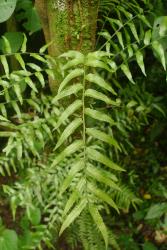Climbing or terrestrial ferns. Rhizomes long-creeping, scaly, bearing short phyllopodia. Rhizome scales peltate, ovate. Fronds monomorphic, articulated to the phyllopodia. Stipes bearing scales and multiseptate hairs. Laminae 1-pinnate to 1-pinnate-pinnatifid, herbaceous to coriaceous, scaly and hairy. Pinnae articulated to rachis, entire or lobed, often auricled on acroscopic side. Veins free or rarely anastomosing, ending in hydathodes inside the lamina margin. Sori round, superficial, near the margin; paraphyses present. Indusia absent (NZ) or reniform (not NZ). Spores monolete; perispores with irregular wing-like folds.
Arthropteris is a clearly defined genus. However the delimitation of several species within the genus remains unresolved, with conflicting interpretations of the A. palisotii complex provided in Flora treatments for Malesia and Australia (Holttum 1964; Bell 1998), and for which genetic analysis has found no clear answer (Liu et al. 2013).
The family relationships of Arthropteris have been contentious. In New Zealand, the genus was previously included within the Davalliaceae by Allan (1961) and Brownsey et al. (1985), and in the Oleandraceae by Brownsey & Smith-Dodsworth (2000). Following Zhang et al. (2016) it is included here with Tectariaceae, but there have been suggestions that it warrants a family of its own (Liu et al. 2013).
In New Zealand, Arthropteris can be recognised by its long-creeping and climbing rhizomes, pinnate fronds that are articulated to phyllopodia on the rhizome, pinnae that are shallowly lobed, auricled on the acroscopic side and articulated to the rachis, and round exindusiate sori situated just inside the margin. The spores have irregular wing-like folds (Large & Braggins 1991).
A genus of 10–20 species centred on the Old World tropics but extending to temperate regions in New Zealand, southern China and as far east as the Juan Fernández Islands (Liu et al. 2013): six species in Africa (Roux 2009), six in Malesia (Holttum 1964), one in China (Xing et al. 2013), four in Australia (Bell 1998), and about five in the Pacific (Nakamura 2008). One non-endemic species in New Zealand.
| Category | Number |
|---|---|
| Indigenous (Non-endemic) | 1 |
| Total | 1 |
The base chromosome number in Arthropteris is x = 41 or 42 (Tindale & Roy 2002).




